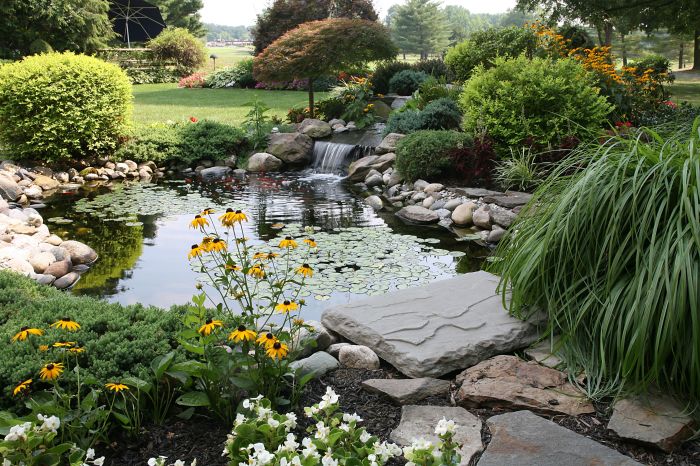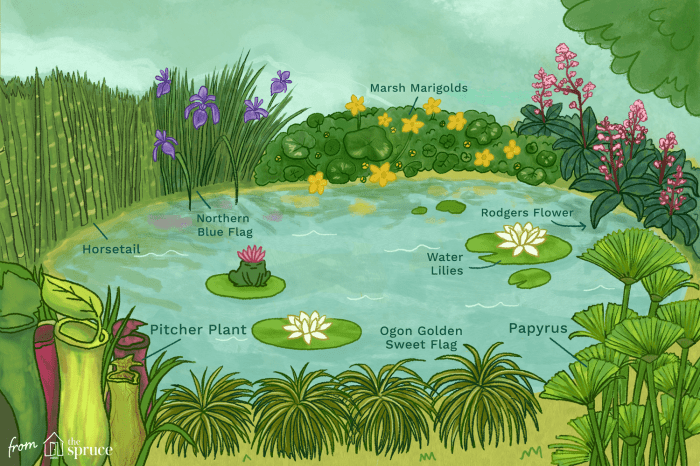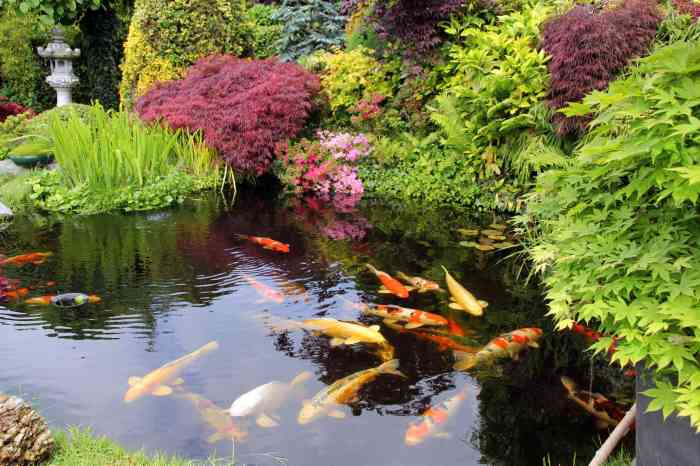Best plants for pond – In the realm of water gardening, the selection of plants plays a pivotal role in creating a thriving ecosystem and enhancing the aesthetic appeal of ponds. From oxygenating species that provide vital life support to floating varieties that add a touch of whimsy, the world of pond plants offers a diverse array of options to suit every taste and need.
This comprehensive guide delves into the best plants for ponds, exploring their unique characteristics, benefits, and care requirements.
As we navigate the fascinating world of pond plants, we will uncover the secrets of oxygenating plants that replenish dissolved oxygen levels, the advantages of floating plants that provide shade and shelter, and the charm of marginal plants that grace the pond’s edges.
We will also explore the underwater realm of submerged plants, essential for providing habitat and food for aquatic creatures, and delve into the beauty of aquatic flowers that attract pollinators and add a splash of color to the pond.
Oxygenating Plants

Oxygenating plants are a vital component of any healthy pond ecosystem. They provide a number of benefits, including:
- Producing oxygen, which is essential for fish and other aquatic life
- Removing carbon dioxide from the water
- Providing shade and shelter for fish and other animals
- Helping to control algae growth
When choosing oxygenating plants for your pond, it is important to select species that are well-suited to your climate and water conditions. Some of the most popular and effective oxygenating plants include:
Submerged Plants
Submerged plants are those that grow entirely underwater. They are the most efficient oxygen producers and are a good choice for ponds with a lot of fish or other aquatic life.
- Anacharis
- Elodea
- Hornwort
- Cabomba
Floating Plants
Floating plants are those that float on the surface of the water. They provide shade and shelter for fish and other animals, and they can also help to control algae growth.
To keep your pond looking its best, it’s important to choose the right plants. Some of the best plants for ponds include water lilies, lotus, and irises. These plants are all relatively easy to care for and can help to create a beautiful and healthy ecosystem in your pond.
However, even the best plants can sometimes develop problems, such as spots on the leaves. If you notice spots on your pond plants, it’s important to identify the cause so that you can take steps to treat it. Spots on Plant: A Comprehensive Guide to Identification Prevention and Treatment provides a wealth of information on how to identify, prevent, and treat spots on plants, so that you can keep your pond plants looking their best.
- Water lilies
- Duckweed
- Water hyacinth
- Salvinia
Marginal Plants
Marginal plants are those that grow in the shallow water around the edge of the pond. They provide a transition zone between the aquatic and terrestrial environments and can help to prevent erosion.
- Cattails
- Bulrushes
- Reeds
- Sedges
When planting oxygenating plants in your pond, it is important to place them in areas where they will receive plenty of sunlight. You should also make sure to plant them at a depth that is appropriate for the species. Most oxygenating plants will do well in water that is 1 to 2 feet deep.
Oxygenating plants are a low-maintenance addition to any pond. They require very little care and will quickly establish themselves in the pond environment. By providing oxygen, removing carbon dioxide, and providing shade and shelter, oxygenating plants help to create a healthy and balanced ecosystem for fish and other aquatic life.
Floating Plants

Floating plants are an essential component of any healthy pond ecosystem. They provide shade, oxygen, and food for aquatic life, and they help to keep the water clean. There are many different types of floating plants, each with its own unique characteristics.
Here is a table comparing the characteristics of some of the most common floating plants:
| Plant | Appearance | Growth Habit | Environmental Preferences |
|---|---|---|---|
| Water hyacinth | Large, rounded leaves with long, trailing roots | Rapidly spreading | Warm, still water |
| Duckweed | Tiny, oval-shaped leaves that float on the surface of the water | Very fast-growing | Warm, still water |
| Water lettuce | Large, round leaves with a ruffled edge | Slow-growing | Warm, still water |
| Frogbit | Small, heart-shaped leaves with a long, trailing stem | Moderate growth rate | Cool, moving water |
When choosing floating plants for your pond, it is important to consider the size of your pond, the amount of sunlight it receives, and the type of fish you have. Some floating plants, such as water hyacinth, can quickly become invasive, so it is important to choose plants that are appropriate for the size of your pond.
Floating plants can be a beautiful and beneficial addition to any pond, but it is important to choose the right plants for your specific needs.
Advantages of Floating Plants
- Provide shade for fish and other aquatic life
- Oxygenate the water
- Help to keep the water clean
- Provide food for fish and other aquatic life
- Can help to control algae growth
Disadvantages of Floating Plants
- Can quickly become invasive
- Can block sunlight from reaching underwater plants
- Can make it difficult to swim or fish in the pond
Marginal Plants
Marginal plants, also known as bog plants, are a vital component of any pond ecosystem. They provide essential habitat for wildlife, help to filter water, and add visual interest to the landscape. When selecting marginal plants, it’s important to consider the size and style of your pond, as well as the amount of sunlight it receives.
The best plants for a pond can enhance its beauty and provide a habitat for wildlife. When selecting plants, consider their size, shape, and color. For example, water lilies are a classic choice for their large, showy blooms. For a more vertical element, consider real hanging plants such as ferns or spider plants.
These can be placed in baskets or containers and suspended above the water, adding a touch of elegance to your pond.
Marginal plants can be divided into three main categories based on their height and spread:
Small Marginal Plants
- Height: Up to 12 inches
- Spread: Up to 18 inches
Small marginal plants are ideal for small ponds or for planting in the foreground of larger ponds. They provide a variety of visual interest, from the delicate flowers of forget-me-nots to the lush foliage of dwarf water lilies.
Medium Marginal Plants
- Height: 12 to 24 inches
- Spread: 18 to 36 inches
Medium marginal plants are a good choice for medium-sized ponds. They provide a variety of visual interest, from the showy flowers of irises to the graceful foliage of rushes.
Large Marginal Plants
- Height: Over 24 inches
- Spread: Over 36 inches
Large marginal plants are best suited for large ponds. They can provide a dramatic focal point, such as the towering stalks of cattails or the broad leaves of water lilies.
When selecting marginal plants, it’s also important to consider their ecological functions. Some marginal plants, such as watercress and duckweed, are excellent at filtering water. Others, such as cattails and rushes, provide important habitat for wildlife. By choosing a variety of marginal plants, you can create a pond that is both beautiful and beneficial to the environment.
Submerged Plants

Submerged plants are those that live entirely underwater, with their roots anchored in the substrate and their leaves and stems extending upwards. They play a crucial role in the ecosystem of a pond, providing habitat and food for aquatic organisms, and producing oxygen through photosynthesis.
Growth Rate, Light Requirements, and Oxygen Production
The growth rate, light requirements, and oxygen production capabilities of submerged plants vary depending on the species. Some plants, such as hornwort (Ceratophyllum demersum), have a rapid growth rate and can quickly form dense stands. Others, such as Vallisneria spiralis, have a slower growth rate and are more suitable for smaller ponds.
Most submerged plants require moderate to high light levels, but some, such as Cryptocoryne wendtii, can tolerate lower light conditions. Submerged plants produce oxygen through photosynthesis, which helps to maintain the oxygen levels in the pond and support the respiration of aquatic organisms.
Planting and Care
Submerged plants can be planted directly into the substrate of the pond or grown in pots. When planting directly into the substrate, it is important to choose a location that receives adequate sunlight. Submerged plants should be spaced apart to allow for proper water flow and circulation.
It is also important to avoid overfeeding the pond, as excess nutrients can lead to algae growth and harm the plants.
For those seeking the best plants for their ponds, it’s worth exploring the vast selection offered by indoor plant stores. Discover the Allure of Indoor Plant Stores: A Guide to Greenery and Decor provides insights into these havens, where experts can assist in choosing the perfect aquatic flora to enhance your pond’s beauty and ecological balance.
Aquatic Flowers

Aquatic flowers add a splash of color and life to ponds, attracting pollinators and enhancing the aesthetic value. These flowers have unique adaptations that allow them to thrive in aquatic environments.
Aquatic flowers bloom at different times of the year, providing a continuous display of beauty. Some popular aquatic flowers include water lilies, lotus flowers, and irises.
Water Lilies, Best plants for pond
Water lilies are a classic aquatic flower, known for their large, showy blooms. They come in a wide range of colors, including white, pink, yellow, and purple. Water lilies bloom from early summer to early fall.
Amongst the array of ideal plants for ponds, the Ribbon Fern stands out as a captivating choice. As discussed in the comprehensive article, Ribbon Fern: An Enduring Beauty Unveiled , this resilient plant boasts a unique charm with its arching fronds that cascade gracefully over water’s edge.
Its ability to thrive in moist environments and provide shade for aquatic life makes it an excellent addition to any pond ecosystem.
Lotus Flowers
Lotus flowers are another popular aquatic flower, known for their delicate blooms and fragrant scent. They come in a variety of colors, including white, pink, yellow, and purple. Lotus flowers bloom from mid-summer to early fall.
Irises
Irises are a type of aquatic flower that grows in shallow water. They come in a wide range of colors, including blue, purple, yellow, and white. Irises bloom from late spring to early summer.
Conclusion: Best Plants For Pond
In conclusion, selecting the best plants for ponds is an art that requires careful consideration of their ecological functions, visual appeal, and maintenance requirements. By understanding the unique characteristics of each plant type, pond owners can create a thriving ecosystem that supports a diverse range of aquatic life while enhancing the beauty and tranquility of their water feature.
FAQ Corner
What are the benefits of oxygenating plants for ponds?
Oxygenating plants release oxygen into the water, which is essential for the survival of fish and other aquatic organisms.
What are the advantages of using floating plants in ponds?
Floating plants provide shade and shelter for fish and other aquatic creatures, and they can also help to reduce algae growth.
How do I choose the right marginal plants for my pond?
When selecting marginal plants, consider the size and style of your pond, as well as the amount of sunlight it receives.
What is the role of submerged plants in ponds?
Submerged plants provide habitat and food for aquatic organisms, and they can also help to oxygenate the water.
Why are aquatic flowers important for ponds?
Aquatic flowers attract pollinators and add a splash of color to ponds, enhancing their aesthetic appeal.